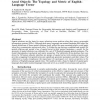Free Online Productivity Tools
i2Speak
i2Symbol
i2OCR
iTex2Img
iWeb2Print
iWeb2Shot
i2Type
iPdf2Split
iPdf2Merge
i2Bopomofo
i2Arabic
i2Style
i2Image
i2PDF
iLatex2Rtf
Sci2ools
114
click to vote
GIS
1998
ACM
1998
ACM
Natural-Language Spatial Relations Between Linear and Areal Objects: The Topology and Metric of English-Language Terms
Spatial relations are the basis for many selections users perform when they query geographic information systems (GISs). Although such query languages use natural-language-like terms, the formal definitions of those spatial relations rarely reflect the same meaning people would apply when they communicate among each other. To bridge the gap between computational models for spatial relations and people’s use of spatial terms in their natural languages, a model for the geometry of spatial relations was calibrated for a set of 59 English-language spatial predicates. The model distinguishes topological and metric properties. The calibration from sketches that were drawn by 34 human subjects identifies ten groups of spatial terms with similar properties and provides a mapping from spatial terms onto significant geometric parameters and their values. The calibration’s results reemphasize the importance of topological over metric properties in the selection of English-language spatial te...
| Added | 22 Dec 2010 |
| Updated | 22 Dec 2010 |
| Type | Journal |
| Year | 1998 |
| Where | GIS |
| Authors | A. Rashid B. M. Shariff, Max J. Egenhofer, David M. Mark |
Comments (0)

